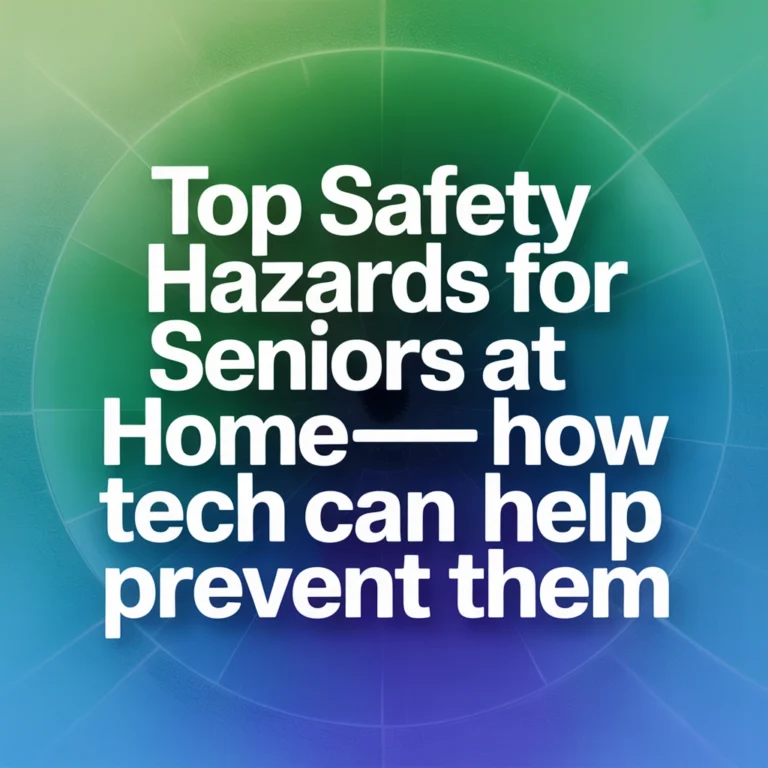In today’s digital landscape, technology isn’t just for the younger generations; it’s a powerful ally for seniors looking to enhance their safety and independence. Gone are the days when aging meant losing touch with the world. Now, tech tools are revolutionizing how older adults navigate daily life, offering unprecedented support that allows them to thrive. With smart gadgets at their fingertips, seniors can take charge of their health and security while staying connected to loved ones in more meaningful ways.
The beauty of these innovations lies not just in their capabilities but in the empowerment they offer. Imagine being able to monitor your heart rate from a comfortable chair or having alerts sent straight to your family. From wearable devices that track vital signs to smart home systems that streamline everyday tasks, modern technology brings peace of mind and control back into seniors’ lives. This article aims to equip you with invaluable safety advice for seniors by highlighting an array of accessible tech-savvy solutions. So buckle up and join us as we explore how embracing technology can lead to stronger connections, safer environments, and ultimately, a richer experience of life!
Safety Tips for Seniors #1: Wearable Health Devices
In our fast-paced digital world, wearable health devices have emerged as powerful allies in monitoring vital signs and health metrics for seniors. These gadgets provide real-time data on heart rate, blood pressure, steps taken, and sleep patterns. By keeping track of these vital statistics, seniors can take proactive steps towards maintaining their well-being while staying informed about changes in their health. Not only do these devices empower older adults to become active participants in their healthcare journey, but they also serve as a source of peace of mind.
One of the most valuable features of many wearable health devices is the ability to send alerts during emergencies. For instance, the Apple Watch includes an ECG app that can detect irregular heart rhythms and notify users if they experience low or high heart rate. Additionally, some wearables come equipped with medication reminders that buzz at set times, ensuring medications are taken as prescribed. This feature is particularly beneficial for seniors managing multiple prescriptions or those who may struggle with memory lapses as they age.
When it comes to popular choices suited for seniors, several options stand out. The Fitbit Charge series offers excellent activity tracking combined with heart rate monitoring and integrates seamlessly with other health management apps. Another noteworthy contender is the Garmin Vivosmart 4—a slim design packed with advanced wellness features like stress tracking and body battery energy monitoring. Finally, there’s the medical-grade device called the AURA Band designed specifically for seniors; it includes comprehensive features such as fall detection and emergency SOS alerts.
These innovative devices not only enhance the independence of aging adults but also cultivate robust communication systems within families and care teams dedicated to keeping loved ones safe. Investing in wearable technology fosters an environment where aging is viewed through an empowering lens instead of one filled with concern—a true leap toward redefining how we support senior living today!
Safety Tips for Seniors #2: Smart Home Systems
Smart home systems represent a remarkable stride in technology that is revolutionizing the way seniors live independently and securely. By automating everyday tasks, these systems not only enhance convenience but also reduce the physical strain of daily activities. Imagine being able to open your front door simply by saying “Open Sesame,” thanks to smart locks, or having lights adjust automatically as the sun sets—all of this is possible with a well-planned smart home setup. Products like the Google Nest Hub allow seniors to manage their homes through voice commands, streamlining everything from alarms to dish updates.
Security is an essential concern for aging adults, and smart home technology offers robust solutions. With devices such as August Smart Lock and Ring Security Cameras, seniors can monitor their homes without added stress. Smart locks enable remote access, so family members can let caregivers in when necessary without needing keys, which can easily be lost or misplaced. Meanwhile, video cameras enhance surveillance and alert users about any unexpected visitors, giving both seniors and their families peace of mind about their safety at home.
Comfort is another crucial aspect where smart home technology shines. Seniors often struggle with adjusting heating and lighting around their routines; however, with smart thermostats like the Ecobee SmartThermostat, they can set their environment according to preferences with just a tap on a smartphone app or voice command. Automatic lighting systems ensure that pathways are illuminated during late-night bathroom trips—reducing fall risks while enhancing comfort and ease of access at all hours.
Overall, incorporating smart home systems into senior living promotes independence while ensuring safety and security. The ability to manipulate one’s environment seamlessly translates into improved quality of life—a core principle here at SeniorThrive. Exploring these options empowers seniors to embrace technology as not just tools but allies in crafting a lifestyle filled with autonomy and dignity.
Safety Tips for Seniors #3: Emergency Response Systems
Personal Emergency Response Systems (PERS) are game-changers in the realm of senior safety. Imagine having a simple device within reach that connects you to help at the mere push of a button! Whether they’re in a home, out on a walk, or even traveling, these devices offer peace of mind for both seniors and their loved ones. PERS can range from wearable pendant buttons to more sophisticated systems that utilize smart technology. As aging doesn’t mean losing autonomy, having easy access to immediate assistance allows seniors to continue living independently with confidence.
When choosing an ideal PERS device, consider several key features that enhance functionality and usability. Look for systems equipped with GPS tracking—should there be a fall or emergency while on the go, family members can quickly locate the individual. Additionally, features like automatic fall detection can save precious time during critical situations by alerting emergency services without any action required from the user. While many systems continue to charge monthly fees, some alternatives include one-time payment options that eliminate ongoing costs—a good choice for budget-savvy families.
Family members play an essential role when it comes to ensuring safety through tech, especially with PERS. Engaging with seniors about their preferences and comfort level with technology is crucial in fostering independence while maintaining security. For instance, assist them in setting up the device and conducting regular checks to ensure it functions properly; this helps demystify technology and encourages open conversations about health and safety needs. Establishing a communication plan whereby seniors know who will respond in case of emergencies reinforces trust—not just in the system but also between family members no matter where they are located.
Finally, integrating various forms of technology strengthens support networks for older adults. Beyond just acquiring a PERS device, consider supplemental safety advice for seniors by leveraging smartphone apps which feature emergency contacts or alert services linked directly to families or caregivers. This multi-faceted approach significantly enhances overall safety while empowering seniors to actively engage with tools designed just for them. Remember: investing in robust emergency response systems is not just about equipment—it’s about creating connections that keep your loved ones thriving as they age stronger together.
Safety Tips for Seniors #4: Communication Tools
In an age where technology permeates every aspect of our lives, staying connected with loved ones has never been easier, especially for seniors. Communication tools such as smartphones and tablets serve as portals to the outside world, bridging gaps that physical distance can create. Not only do these devices allow for direct interaction with family members and friends, but they also open up new avenues to nurture relationships through text messaging and video calls. Embracing these technologies helps combat feelings of isolation often experienced by older adults, fostering a sense of connection and community.
User-friendly apps play a crucial role in facilitating communication for seniors who may not feel technically savvy. For instance, Zoom allows users to easily host virtual gatherings or catch up with family over a face-to-face call without the hassle of complex setups. Similarly, WhatsApp provides a simple interface for sending text messages, making voice calls, and even sharing photos—all in real time. These platforms prioritize accessibility with large buttons and intuitive designs tailored to enhance user experience regardless of technological proficiency.
Social media is another transformative tool that can elevate social engagement among seniors. Platforms like Facebook encourage users to connect with old friends and share life updates—helping reduce that loneliness that too many older adults face today. Within groups focused on hobbies or interests specific to seniors, members can find encouragement, support, and companionship in their shared passions. Additionally, services like AARP Connect offer opportunities for meaningful conversations in more focused communities designed just for older adults.
Furthermore, it’s essential to guide seniors on how to best utilize these communication tools while helping them identify trustworthy resources for learning about technology safely. Encouragement from family members or caregivers goes a long way; jumping into video calls together or setting up social media accounts side-by-side instills confidence while opening doors full of conversation and connection—a perfect combination for enriching an aging lifestyle.
Safety Tips for Seniors #5: Smart Mobility Aids
In our fast-paced world, getting out and about can be a challenge for seniors. But smart mobility aids are here to transform everyday travel into a breeze. GPS-enabled devices, such as the Garmin DriveSafe or the Apple AirTag, offer more than just navigation. These tools allow users to set predetermined routes, track their whereabouts in real-time, and receive notifications. By utilizing this technology, seniors can maintain their independence while ensuring loved ones have an added layer of safety awareness.
Additionally, the emergence of smart fall detection technologies cannot be understated. Products like the Life Alert and Philips Lifeline come equipped with sensors that detect falls and automatically alert emergency services when necessary. This feature is crucial for older adults who may feel unsteady on their feet or fear being alone. Knowing that help is just a button press—or automatic notification—away can significantly boost confidence when moving around independently.
Mobility products designed specifically for seniors also play an essential role in making outdoor excursions safe and enjoyable. Devices like electric scooters and walkers with built-in GPS capabilities not only aid in mobility but also integrate safety features. Companies like Drive Medical offer products engineered with comfort in mind while maintaining functional elements that promote independence for aging users.
As we emphasize safety advice for seniors, it’s worth noting that embracing these technological advancements fosters confidence and autonomy among older adults. They not only enhance daily living but also ensure that barriers to activity diminish significantly.
Safety Tips for Seniors #6: Cybersecurity Awareness
In a world where technology is woven into our daily lives, understanding online safety and privacy has never been more crucial—especially for seniors. Unfortunately, older adults are often targeted by cybercriminals who exploit their unfamiliarity with digital tools. The consequences can be dire: loss of personal information, financial hardship, and emotional distress. By becoming tech-savvy in cybersecurity practices, seniors can safeguard their data and enjoy the benefits of technology without fear.
Recognizing scams is the first line of defense against potential threats. Seniors should be on high alert for phishing emails that appear to come from trusted sources but ask for sensitive information. Common scams include fake lottery winnings or urgent messages claiming there’s an issue with a bank account requiring immediate rectification. Educating yourself or your loved ones about these tactics is essential; simple habits like scrutinizing email addresses, ignoring unsolicited messages, and never clicking on mysterious links can significantly decrease the risk of falling victim to frauds.
Several valuable tools can help bolster cybersecurity measures for older adults. Password managers like LastPass assist users in creating unique passwords for every service while securely storing them in one place. Additionally, antivirus software such as Norton helps protect devices from malware and viruses that could compromise personal information. Encouraging technology use among seniors while simultaneously arming them with protective resources creates a powerful combination—transforming hesitation into confidence as they explore new horizons safely.
While navigating the digital landscape may seem daunting at times, it’s important for seniors to know that maintaining safety online isn’t just possible; it’s empowering! After all, each click should resonate with strength and self-assurance—not apprehension or vulnerability.
Safety Tips for Seniors #7: Health Management Apps
Managing health becomes increasingly vital, and technology has stepped up to support seniors. Health management apps are revolutionizing how older adults track medications, monitor appointments, and manage chronic conditions. These tools simplify the complicated web of healthcare. By embracing these apps, seniors can take an active role in their own health.
For those juggling multiple prescriptions or visits to various specialists, there’s an app like Medisafe. This user-friendly platform sends reminders for medications and allows users to keep a detailed log of dosages and refill dates. It even connects to pharmacy services so you can receive timely alerts when it’s time for refills.
Keeping track of appointments can be just as daunting, but solutions like MyTherapy help streamline that process too. This comprehensive app combines medication tracking with appointment scheduling and even health measurement logs to compile all health data in one place. Users can set custom reminders for tasks related to their health care routine which helps avoid missed appointments with doctors.
Seniors managing chronic conditions may find apps specifically tailored for their needs particularly useful. For example, Glucose Buddy is designed for individuals managing diabetes; it helps track blood sugar levels. By utilizing these technologies creatively integrated into daily life, seniors can not only improve their quality of care but also enjoy a greater sense of independence. Embracing health management apps isn’t just about adapting; it’s about thriving during the golden years!
Creating a Tech-Safe Environment
In today’s digital age, creating a tech-safe environment is essential for seniors to enjoy the benefits of technology. Ensuring proper internet security settings at home can feel overwhelming, but it’s crucial for protecting personal information and data from cyber threats. Start by updating your router with a strong password and enabling encryption features such as WPA3. Websites like StaySafeOnline.org provide tips and resources on how to maintain safe browsing habits, helping seniors understand the importance of recognizing secure connections and phishing attempts.
Caregivers play a pivotal role in establishing this tech-savvy safety net. By assisting seniors in setting up devices caregivers can empower them to use technology effectively. It’s beneficial to conduct regular check-ins to ensure devices have the latest software updates and that privacy settings are correctly configured. Many caregivers find platforms like Evermind.com helpful for remote monitoring of loved ones’ device activity.
Encouraging independence among seniors while maintaining necessary supervision also requires striking the right balance. Teaching older adults how to navigate technology safely allows them to take charge of their own lives confidently. However, caregivers should remain available as support when challenges arise. Establishing regular times for tech training sessions or informal get-togethers can create an atmosphere where tech skills flourish.
Empowering our elders with technology doesn’t just revolve around gadgets; it’s about cultivating an environment that champions safety and confidence in everyday use.
Embracing Technology for a Safer Future
It’s crucial to underscore the transformative impact technology can have on enhancing the safety and quality of life for older adults. From wearable health devices to smart home systems, these tools empower seniors to embrace their independence. Each device in this article is a step toward not just surviving but thriving—allowing you or your loved ones to live boldly without fear.
Another thing, using SeniorThrive App, is a great source for safety advice, resources for great reads about seniors and caregiving, and plenty more. So, take action! Dive into the world of technology with an open mind and explore the vast array of options for senior safety. There’s no one-size-fits-all solution; what matters is finding the right mix of devices and apps. Remember, staying engaged with technology isn’t just smart; it is essential.



